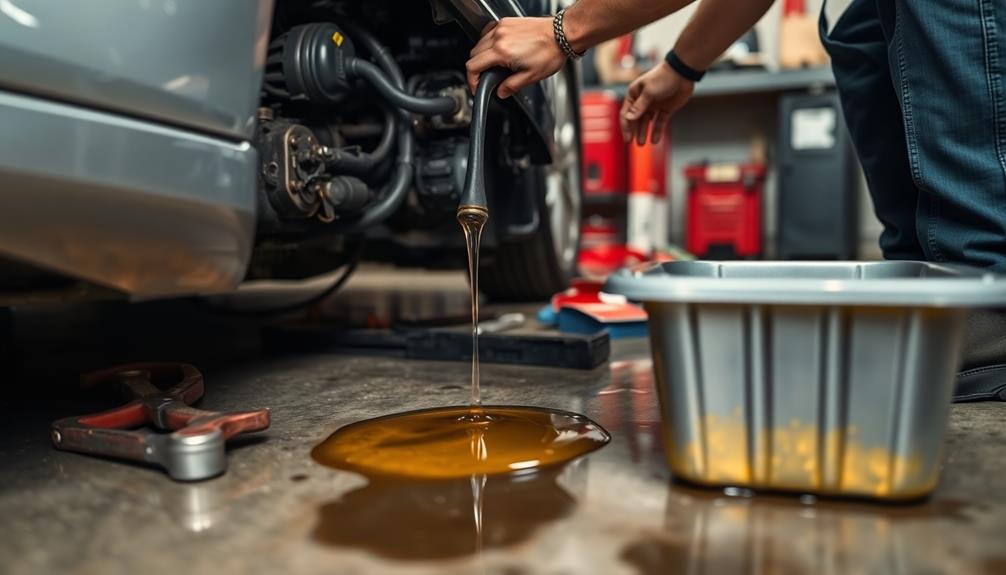If your turbocharger is failing, you’ll notice reduced power, sluggish acceleration, and a drop in boost pressure. You might hear whining or grinding noises and see blue smoke from the exhaust, indicating oil leaks. Overheating or excessive emissions can also be signs of trouble. Watch for oil spots or increased oil consumption too. Recognizing these signs early can save your engine from serious damage—continue to explore more ways to identify issues before they worsen.
Key Takeaways
- Noticeable drop in boost pressure causing sluggish acceleration and loss of power.
- Unusual noises like whining, grinding, or rattling from the turbo area.
- Oil leaks around the turbo housing or bluish exhaust smoke indicating seal failure.
- Excessive exhaust smoke, engine overheating, or check engine light signaling turbo or seal issues.
- Reduced engine performance, increased oil consumption, or visible oil spots indicating turbo deterioration.

A turbocharger is a vital component that boosts your engine’s performance, but it can show warning signs when it starts to fail. One of the first indicators you might notice is a drop in boost pressure. When the turbo isn’t functioning properly, the engine won’t produce the same power and acceleration you’re used to. You may feel sluggishness during acceleration or notice a lack of the usual boost sounds. This drop in boost pressure often points to problems such as damaged turbine blades, clogged intercoolers, or worn-out wastegates. If you observe a consistent reduction in engine power, it’s a clear sign you should investigate the turbocharger’s health.
Oil leaks are another common warning sign of turbo failure. Since the turbo relies heavily on oil for lubrication and cooling, any leaks can markedly impair its functioning. Oil leaks around the turbo’s housing or into the intake or exhaust pipes indicate that seals or gaskets are failing. These leaks not only diminish lubrication, risking further damage, but also can cause smoke from the exhaust. A bluish smoke trail is often associated with oil burning inside the engine, which occurs when oil leaks past the turbo seals into the combustion chamber. If you notice oil spots under your vehicle or an increase in oil consumption, it’s time to check the turbo for leaks and possible seal failures.
Oil leaks around the turbo indicate seal failure and can cause smoke and engine damage.
Another sign to watch for is unusual noises coming from the turbo area. Whining, grinding, or rattling sounds can point to bearing failure or damaged turbine blades. These noises often become more pronounced during acceleration or deceleration. When the bearings wear out, the turbo’s spinning components don’t stay balanced, leading to vibrations and noise. This can further damage the turbo and related engine parts if ignored. Along with noise, you might experience increased exhaust emissions or a burning smell, both indicative of oil leaks or overheating issues within the turbo.
You should also be alert to excessive exhaust smoke, especially if it has a bluish tint. This usually signals oil entering the combustion chamber due to seal or turbo bearing failure. As oil burns along with fuel, it causes visible smoke and can damage your engine over time. If your engine runs hotter than usual or the check engine light illuminates, these could also be signs of turbo problems. Addressing these issues early can prevent more costly repairs and maintain your engine’s peak boost pressure and performance. Recognizing these warning signs promptly helps you keep your turbocharger—and your engine—running smoothly. Additionally, proper maintenance with quality oils and filters can extend the lifespan of your turbo components and prevent premature failures.
Frequently Asked Questions
Can Turbocharger Failure Be Prevented With Regular Maintenance?
Yes, regular preventive maintenance can help prevent turbocharger failure and extend its lifespan. By routinely checking and changing oil, air filters, and inspecting for leaks or debris, you guarantee the turbo operates smoothly. Proper maintenance reduces stress on components, minimizes wear, and catches potential issues early. Staying consistent with these practices keeps your turbocharger functioning efficiently, ultimately prolonging its lifespan and avoiding costly repairs down the road.
How Long Does a Typical Turbocharger Last Before Failure?
A typical turbocharger lasts between 150,000 to 200,000 miles, but its lifespan depends on driving habits and maintenance. You’ll notice turbo failure signs like reduced power, unusual noises, or excessive smoke, which indicate it’s nearing the end of its turbo lifespan. To extend its life, keep up with regular oil changes and avoid aggressive driving, helping you prevent premature turbo failure.
Are There Specific Driving Habits That Increase Turbocharger Risk?
Yes, aggressive driving and frequent idling can increase your turbocharger‘s risk. When you accelerate rapidly, the turbo works harder, causing more wear and tear. Constantly stopping and starting your engine also prevents proper cooling, leading to potential damage. To extend your turbo’s lifespan, drive smoothly, avoid excessive revving, and try to minimize unnecessary idling. Proper driving habits help keep your turbocharger functioning efficiently longer.
What Are the Costs Associated With Turbocharger Repairs or Replacements?
Think of turbocharger repairs like fixing a complex engine; costs can vary widely. You might spend anywhere from $500 for minor repairs to over $2,500 for a full replacement. A thorough cost analysis helps you prepare for repair expenses, especially if your turbo fails unexpectedly. Keep in mind, neglecting issues can escalate costs, turning a simple fix into a costly overhaul. Staying proactive saves you money in the long run.
How Can I Differentiate Turbocharger Issues From Other Engine Problems?
You can tell turbocharger issues apart from other engine problems by listening for turbo noise, like whining or grinding sounds, and noticing boost loss, which causes reduced power and acceleration. If your engine feels sluggish and you hear unusual noises, it’s likely a turbo problem. These signs differ from typical engine troubles, helping you identify whether the turbocharger needs inspection or repair before further damage occurs.
Conclusion
Keep an eye out for these signs so you can catch turbocharger issues early—like a vigilant knight spotting trouble in the kingdom. Ignoring symptoms could leave you stranded, much like a lone sailor lost at sea. Don’t let your engine’s heart fade into the shadows; address problems promptly to keep things running smoothly. Remember, even the mightiest steeds need care—your turbocharger’s failure is no different, and timely action saves the day.









